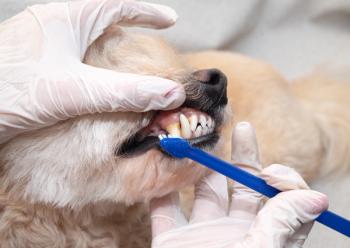
Caring for your anesthetic unit and veterinary dental monitoring equipment
Tips and tricks to ensure you don't ruin this essential, expensive equipment.
Some years ago, I was asked to conduct an efficacy study comparing antibiotics when used in a pulse fashion (first five days of each month) vs. no antimicrobial use to control the progression of canine Stage 3 periodontal disease. In that study, the sponsoring company agreed to pay all fees related to dental care for those chosen for the study. There was little problem getting 90 clients to enroll their dogs. The plan was to anesthetize all patients every six months for clinical probing and radiographic evaluation.
Unfortunately, only seven completed the study, which was not statistically significant. Why so few? The pet owners were afraid of the anesthesia involved to properly evaluate the progression of disease, even though they were informed beforehand it would be required multiple times.
This experience reinforced my impression that it was primarily anesthetic concerns and not expense that controlled the apprehension surrounding dental care. Thus, attaining the best compliance required choosing the proper patient, selecting the right anesthetic protocol and monitoring the anesthetized patient properly with well-maintained equipment.
I soon found out purchasing "the best" anesthetic machine and monitoring system was not enough to ensure an excellent anesthetic experience. At the trade shows and out of the box, the monitors worked flawlessly—all the electrocardiogram tracings were large and bright, the audible beep was loud and regular and the pulse oximeter and end tidal carbon dioxide provided consistent readings.
Then about a month after purchase, I would look up at the large screen and could barely read the ECG, and the end tidal carbon dioxide volume alarm was constantly alerting. What was wrong with these units? After acquiring three other veterinary monitoring systems with the same results, the harsh reality set in. The problem with the units was not the manufacturer, it was us—how our staff took care of what we had. I hope what we learned can benefit others.
What went wrong?
I learned that the types of issues and frequency with which we were experiencing them were not necessarily unusual for a busy practice, even with minimal staff turnover. The problems we experienced with the monitors were related to monitoring knowledge, proper use and care of the accessories and expectations regarding their durability.
Accessories are considered consumable items and, based on their direct contact with the patients, are subject to wear and tear. They will definitely need to be replaced from time to time. This was a harsh reality for us. I was used to paying for the highest quality equipment, and I expected it to work seamlessly without much additional expense. How often the accessories are used and how they are cared for directly impact the frequency of replacement.
That said, the rate at which our staff went through pulse oximeter sensors seemed exceedingly high. At $250 each, according to the distributor, most customers take extraordinary care of these and make sure that every staff member is trained and held responsible for treating them properly—if not out of the box, certainly after the first time they need to purchase a replacement. They generally have a warrantee of six to nine months, which is the timeline the manufacturer uses to determine where their responsibility for production quality ends and where normal wear and tear, frequency of use and care begin to take their toll.
Photo 1: Improper storage of blood pressure cuffs.
What we learned
For us, the best approach was to schedule a formal monitoring training session for our entire technician staff. The manufacturer's representative did hands-on training, demonstrating the tips and tricks of taking care of the monitoring equipment and accessories. We also developed a written protocol for the "proper care and feeding" so that we will always have a reference document on site (email me at
Photo 2: Dangerous stress placed on the cuff because of improper storage.
Blood pressure cuffs
When a blood pressure cuff's Velcro® (Velcro Industries B.V.) wears out, it is time for a new cuff. Simply taping the cuff will cause inaccurate readings. Also, watch closely how the blood pressure cuffs are stored after use. They should be disconnected from the unit and stored flat. Storing them on the unit often creates abnormal stress on plastic surfaces (Photos 1 and 2). TIP: Keep the cuff clean by wiping with alcohol after each use.
Photo 3: Pointers for pulse oximeter sensors-don't tightly wrap the wire; don't yank or pull the sensor off but unclip it and clean the sensor with a 70 percent alcohol wipe; never submerge it or clean with chlorhexidine.
Pulse oximeter sensor
If the infrared light on the pulse oximeter sensor is intermittent, it means that the thin internal wires have frayed or are pulling apart at the junction—a precursor to complete sensor failure. Although these can sometimes be repaired for a fraction of the replacement cost, always have a spare pulse oximeter sensor to use in the meantime. Having a working spare will also allow you to troubleshoot the parameter to eliminate the possibility that the problem resides in the monitor itself. TIP: Only wipe the sensor clean with alcohol; never use other cleaners that may damage plastic. Never wind the wires tightly or yank the clips off when changing them—be sure to unclip them before moving a patient (Photos 3 and 4).
Photo 4: Proper storage of monitor wires-note the pulse oximeter sensor wires are not coiled.
Carbon dioxide sampling lines
The moment an occlusion alarm is rendered, replace the sampling line. If visible moisture is evident beyond the neoprene filter, hang the line to dry. Failing to do this risks that the moisture will reach the internal module and burn out the circuitry (Photos 5 and 6). TIP: Hang the line to dry between cases. Never force air through the line to expedite drying because it will destroy the filter.
Photo 5: Pointers for carbon dioxide lines-wipe the adapters to clean them, but do not force water through or submerge them; hang them dry to allow moisture to evaporate.
ECG leads and clips
Green or black buildup on the copper clips can be part of normal oxidation and should be regularly cleaned—or the buildup can mean your staff is mistakenly using ultrasound gel (acoustic gel) rather than electrode paste (conductive) to maintain good contact. Ultrasound gel will not only block the electrical signal, it will also quickly degrade the clips (Photo 7). TIP: Clean the clips by gently wiping with alcohol or by using an instrument brush. Never wind the line tightly to store, and never ever use ultrasound gel instead of electrode gel.
Photo 6: Moisture has made it beyond the neoprene filter and stands just before the second filter at the monitor junction.
Anesthesia machine
A leak test should be performed before every procedure. By verifying there are no leaks in the machine, you allow the correct flow rate of oxygen and percentage of inhalant drug to be administered to the patient. Such leaks are not only wasteful, but they can compromise the safety of the patient. TIP: Perform a leak test between each procedure, and replace the maintenance kit annually, including the black rubber tubing, domes, gaskets, flutter discs, etc. These rubber parts should also be cleaned daily with mild soap and water.
Photo 7: Pointers for ECG leads and clips-use electrode paste, not ultrasound gel to maintain good contact; keep the copper clips clean of debris and buildup; use a gentle touch when applying and unclipping leads.
Breathing bag and breathing circuit
The breathing bag and breathing circuit should be washed and hung to dry after each procedure. If a bag or circuit is used continually without being cleaned, disease and infections could be passed to other patients. TIP: If a tear in a bag or breathing circuit appears, that particular bag or circuit should be replaced. Taping the circuit or bag may continue to allow a leak in the system and waste oxygen and the inhalant drug.
Carbon dioxide absorber
Carbon dioxide absorbent granules are designed to scrub the expired gases of carbon dioxide, and the reaction causes the granular absorbent material to change color (bluish gray or purple) as a visual guide. However, this absorbent material will be depleted after only a matter of hours, and the material will return almost to its original color overnight—a phenomenon known as regeneration. Depleted granules are hard to the touch and not easily crushed when pressed between the fingers when compared with fresh absorbent material. Also, channeling of gases may occur, leaving the visible granules against the sides of the canister fresh, while the gases pass through the expired granules in the center, sending the carbon dioxide back to the patient. TIP: Keep a log sheet next to the machine, and replace the absorbent material after every six to eight hours of use.
Vaporizer
To ensure the accuracy of anesthesia delivery, the vaporizer should be professionally serviced every year. Some companies have an exchange program in which they send you a reconditioned vaporizer in exchange for the one in current use. Failure to do so could result in patients being too light (and waking up during the procedure) or too deep, compromising their vital organs. TIP: In most cases, the vaporizers cannot be serviced in the field since this needs to be done in a temperature- and humidity-controlled environment.
Who pays?
Now on all of our invoices there is a line item for hourly anesthesia monitoring. This allows our practice to update and maintain our anesthesia and monitoring equipment and accessories. Everyone wins.
Acknowledgments
I'd like to thank Andrew Schultz, director of Monitoring and Critical Care, Midmark Animal Health, as a key source for this article.
Dr. Bellows owns ALL PETS DENTAL in Weston, Fla. He is a diplomate of the American Veterinary Dental College and the American Board of Veterinary Practitioners. He can be reached at (954) 349-5800; e-mail:
Newsletter
From exam room tips to practice management insights, get trusted veterinary news delivered straight to your inbox—subscribe to dvm360.






